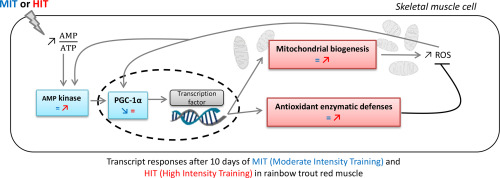当前位置:
X-MOL 学术
›
Comp. Biochem. Physiol. A Mol. Integr. Physiol.
›
论文详情
Our official English website, www.x-mol.net, welcomes your
feedback! (Note: you will need to create a separate account there.)
Training protocols differently affect AMPK-PGC-1α signaling pathway and redox state in trout muscle.
Comparative Biochemistry and Physiology A: Molecular & Integrative Physiology ( IF 2.1 ) Pub Date : 2020-02-07 , DOI: 10.1016/j.cbpa.2020.110673 Morgane Pengam 1 , Christine Moisan 1 , Bernard Simon 1 , Anthony Guernec 1 , Manon Inizan 1 , Aline Amérand 1
Comparative Biochemistry and Physiology A: Molecular & Integrative Physiology ( IF 2.1 ) Pub Date : 2020-02-07 , DOI: 10.1016/j.cbpa.2020.110673 Morgane Pengam 1 , Christine Moisan 1 , Bernard Simon 1 , Anthony Guernec 1 , Manon Inizan 1 , Aline Amérand 1
Affiliation

|
Beneficial effects of physical exercise training are in part related to enhancement of muscle mitochondrial performance. The effects of two different trainings were investigated on transcripts and proteins of the AMPK-PGC-1α signaling pathway, the mitochondrial functioning (citrate synthase (CS), oxidative phosphorylation complexes, uncoupling proteins (UCP)) and the antioxidant defenses (superoxide dismutase (SOD), glutathione peroxidase (GPx), catalase) in rainbow trout red and white skeletal muscles. One group of trouts swam for 10 days at a moderate intensity (approximately 57% Ucrit or 2.0 body lengths/s, 23.5 h/day) and another group at a high intensity (approximately 90% Ucrit or 3.2 body lengths/s, 2 h/day). In the red muscle, the increase of Cs mRNA levels was significantly correlated with the transcripts of Ampkα1, Ampkα2, Pgc-1α, the oxidative phosphorylation complexes, Ucp2α, Ucp2β, Sod1, Sod2 and Gpx1. After 10 days of training, high intensity training (HIT) stimulates more the transcription of genes involved in this aerobic pathway than moderate intensity training (MIT) in the skeletal muscles, and mainly in the red oxidative muscle. However, no changes in CS, cytochrome c oxidase (COX) and antioxidant defenses activities and in oxidative stress marker (isoprostane plasmatic levels) were observed. The transcriptomic responses are fiber- and training-type dependent when proteins were not yet expressed after 10 days of training. As in mammals, our results suggest that HIT could promote benefit effects in fish.
中文翻译:

训练方案对鳟鱼肌肉中AMPK-PGC-1α信号通路和氧化还原状态的影响不同。
体育锻炼的有益效果部分与增强肌肉线粒体性能有关。研究了两种不同训练对AMPK-PGC-1α信号通路的转录本和蛋白质,线粒体功能(柠檬酸合酶(CS),氧化磷酸化复合物,解偶联蛋白(UCP))和抗氧化剂防御(超氧化物歧化酶( SOD),谷胱甘肽过氧化物酶(GPx),过氧化氢酶)在虹鳟鱼的红色和白色骨骼肌中。一组鳟鱼以中等强度游泳(约57%乌克利特或2.0体长/秒,23.5小时/天)游泳10天,另一组以高强度(大约90%乌克利特或3.2体长/秒,2小时/天)游泳/天)。在红色肌肉中,Cs mRNA水平的增加与Ampkα1,Ampkα2,Pgc-1α的转录本显着相关。氧化磷酸化复合物Ucp2α,Ucp2β,Sod1,Sod2和Gpx1。经过10天的训练,与骨骼肌(主要是红色氧化肌)的中等强度训练(MIT)相比,高强度训练(HIT)刺激该有氧途径中涉及的基因转录更多。但是,未观察到CS,细胞色素C氧化酶(COX)和抗氧化剂防御活性以及氧化应激标记物(异前列腺素血浆水平)的变化。当训练10天后蛋白质仍未表达时,转录组反应取决于纤维和训练类型。与在哺乳动物中一样,我们的结果表明HIT可以促进鱼类的有益效果。高强度训练(HIT)比骨骼肌(主要是红色氧化性肌肉)中强度训练(MIT)刺激更多的有氧途径相关基因的转录。但是,未观察到CS,细胞色素C氧化酶(COX)和抗氧化剂防御活性以及氧化应激标记物(异前列腺素血浆水平)的变化。当训练10天后蛋白质仍未表达时,转录组反应取决于纤维和训练类型。与在哺乳动物中一样,我们的结果表明HIT可以促进鱼类的有益效果。高强度训练(HIT)比骨骼肌(主要是红色氧化性肌肉)中强度训练(MIT)刺激更多的有氧途径相关基因的转录。但是,未观察到CS,细胞色素C氧化酶(COX)和抗氧化剂防御活性以及氧化应激标记物(异前列腺素血浆水平)的变化。当训练10天后蛋白质仍未表达时,转录组反应取决于纤维和训练类型。与在哺乳动物中一样,我们的结果表明HIT可以促进鱼类的有益效果。观察到细胞色素C氧化酶(COX)和抗氧化防御活性以及氧化应激标记物(异前列腺素血浆水平)。当训练10天后蛋白质仍未表达时,转录组反应取决于纤维和训练类型。与在哺乳动物中一样,我们的结果表明HIT可以促进鱼类的有益效果。观察到细胞色素C氧化酶(COX)和抗氧化防御活性以及氧化应激标记物(异前列腺素血浆水平)。当训练10天后蛋白质仍未表达时,转录组反应取决于纤维和训练类型。与在哺乳动物中一样,我们的结果表明HIT可以促进鱼类的有益效果。
更新日期:2020-02-07
中文翻译:

训练方案对鳟鱼肌肉中AMPK-PGC-1α信号通路和氧化还原状态的影响不同。
体育锻炼的有益效果部分与增强肌肉线粒体性能有关。研究了两种不同训练对AMPK-PGC-1α信号通路的转录本和蛋白质,线粒体功能(柠檬酸合酶(CS),氧化磷酸化复合物,解偶联蛋白(UCP))和抗氧化剂防御(超氧化物歧化酶( SOD),谷胱甘肽过氧化物酶(GPx),过氧化氢酶)在虹鳟鱼的红色和白色骨骼肌中。一组鳟鱼以中等强度游泳(约57%乌克利特或2.0体长/秒,23.5小时/天)游泳10天,另一组以高强度(大约90%乌克利特或3.2体长/秒,2小时/天)游泳/天)。在红色肌肉中,Cs mRNA水平的增加与Ampkα1,Ampkα2,Pgc-1α的转录本显着相关。氧化磷酸化复合物Ucp2α,Ucp2β,Sod1,Sod2和Gpx1。经过10天的训练,与骨骼肌(主要是红色氧化肌)的中等强度训练(MIT)相比,高强度训练(HIT)刺激该有氧途径中涉及的基因转录更多。但是,未观察到CS,细胞色素C氧化酶(COX)和抗氧化剂防御活性以及氧化应激标记物(异前列腺素血浆水平)的变化。当训练10天后蛋白质仍未表达时,转录组反应取决于纤维和训练类型。与在哺乳动物中一样,我们的结果表明HIT可以促进鱼类的有益效果。高强度训练(HIT)比骨骼肌(主要是红色氧化性肌肉)中强度训练(MIT)刺激更多的有氧途径相关基因的转录。但是,未观察到CS,细胞色素C氧化酶(COX)和抗氧化剂防御活性以及氧化应激标记物(异前列腺素血浆水平)的变化。当训练10天后蛋白质仍未表达时,转录组反应取决于纤维和训练类型。与在哺乳动物中一样,我们的结果表明HIT可以促进鱼类的有益效果。高强度训练(HIT)比骨骼肌(主要是红色氧化性肌肉)中强度训练(MIT)刺激更多的有氧途径相关基因的转录。但是,未观察到CS,细胞色素C氧化酶(COX)和抗氧化剂防御活性以及氧化应激标记物(异前列腺素血浆水平)的变化。当训练10天后蛋白质仍未表达时,转录组反应取决于纤维和训练类型。与在哺乳动物中一样,我们的结果表明HIT可以促进鱼类的有益效果。观察到细胞色素C氧化酶(COX)和抗氧化防御活性以及氧化应激标记物(异前列腺素血浆水平)。当训练10天后蛋白质仍未表达时,转录组反应取决于纤维和训练类型。与在哺乳动物中一样,我们的结果表明HIT可以促进鱼类的有益效果。观察到细胞色素C氧化酶(COX)和抗氧化防御活性以及氧化应激标记物(异前列腺素血浆水平)。当训练10天后蛋白质仍未表达时,转录组反应取决于纤维和训练类型。与在哺乳动物中一样,我们的结果表明HIT可以促进鱼类的有益效果。











































 京公网安备 11010802027423号
京公网安备 11010802027423号